

Welcome - Fritzing. FPGALink: Easy USB to FPGA Communication. Page created on 2011-03-26 at 0:13:02 UTC by Chris – 32 Comments Because of its ubiquity, USB provides a good mechanism for JTAG-programming Field-Programmable Gate Arrays, but it also provides a good conduit for the host to exchange data with the FPGA, once programmed. FPGA development kits incorporating some kind of USB-capable microcontroller are common, and cheap. Unfortunately there is a confusing variety of different devkits, with different FPGAs and different USB microcontrollers, and a general lack of good software and firmware for interacting with them, and the software that is provided is often released under a restrictive license, or only available for one platform.
The FPGALink library is my attempt to provide an end-to end solution capable of JTAG-programming the FPGA on a variety of USB-based hardware platforms, and subsequently communicating with it using a straightforward API on the host side and a standard FIFO interface on the FPGA side. FPGA simulation. FPGA pin assignment Your FPGA needs to communicate with the outside world.

The signals that are exported from your design are connected to the FPGA user pins (if your design is hierarchical, the signals from your "top-level" are the ones connected to the user pins). The top-level file usually does not specify which signal goes to which pin. If you do not specify anything, the FPGA software makes a (more or less) random assignment. For most practical purpose, you need to create pin assignments. Pin assignment files are text files, but with a proprietary format.
OverviewEmbedded Systems Guide. An application-specific integrated circuit (ASIC) is an integrated circuit (IC) that has been customized for a specific use.
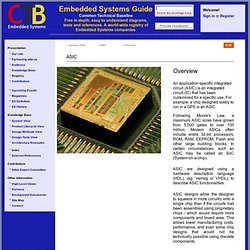
For example, a chip designed solely to run in a GPS is an ASIC. Following Moore's Law, a maximum ASIC sizes have grown from 5,000 gates to over 100 million. Modern ASICs often include entire 32-bit processors, ROM, RAM, EEPROM, Flash and other large building blocks. In certain circumstances, such an ASIC may be called an SoC (System-on-a-chip). ASIC are designed using a hardware description language (HDL), (eg: Verilog or VHDL), to describe ASIC functionalities. ASIC designs allow the designer to squeeze in more circuitry onto a single chip than if the circuits had been assembled using proprietary chips - which would require more components and board area.
PSPICE 9.1 student version. Robotics and Automation: V-REP Robot Simulator now on all Platforms. ROS Interface also Available. We are happy to announce that the V-REP robot simulator is now available on all major platforms (Windows / Mac OSX / Linux), and features a powerful ROS interface.

Students may use V-REP with full functionality for free. V-REP is the Swiss army knife among robot simulators: hundreds of features and functions, and a very elaborate API: For more information, please visit or have a look at following demo video:Or visit us at IROS, at Hibot's booth. Best regards, Project Lab. Difficulty Level = 5 [What's this?]
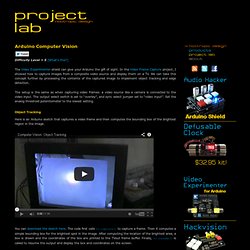
The Video Experimenter shield can give your Arduino the gift of sight. In the Video Frame Capture project, I showed how to capture images from a composite video source and display them on a TV. We can take this concept further by processing the contents of the captured image to implement object tracking and edge detection. The setup is the same as when capturing video frames: a video source like a camera is connected to the video input. The output select switch is set to “overlay”, and sync select jumper set to “video input”. Object Tracking Here is an Arduino sketch that captures a video frame and then computes the bounding box of the brightest region in the image.
You can download the sketch here. Keep in mind that there is no need to display any output at all — we just do this so we can see what’s going on. If you use a television with the PAL standard (that is, you are not in North America), change tv.begin(NTSC, W, H) to tv.begin(PAL, W, H). Building robots instead of sleeping. Home Projects Shop Forums Download About JRO Other NEW version 1.1 of the hardware has been completed!
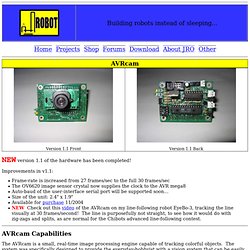
Improvements in v1.1: Robotics. Robotics is the branch of mechanical engineering, electrical engineering and computer science that deals with the design, construction, operation, and application of robots,[1] as well as computer systems for their control, sensory feedback, and information processing.

These technologies deal with automated machines that can take the place of humans in dangerous environments or manufacturing processes, or resemble humans in appearance, behavior, and/or cognition. Many of today's robots are inspired by nature contributing to the field of bio-inspired robotics. The concept of creating machines that can operate autonomously dates back to classical times, but research into the functionality and potential uses of robots did not grow substantially until the 20th century.[2] Throughout history, robotics has been often seen to mimic human behavior, and often manage tasks in a similar fashion.
Etymology[edit] History of robotics[edit] Robotic aspects[edit] CCNet - ee192c. EECS 149 and 249M: Introduction to Embedded Systems. EECS 149/249A introduces students to the design and analysis of computational systems that interact with physical processes.

Applications of such systems include medical devices and systems, consumer electronics, toys and games, assisted living, traffic control and safety, automotive systems, process control, energy management and conservation, environmental control, aircraft control systems, communications systems, instrumentation, critical infrastructure control (electric power, water resources, and communications systems for example), robotics and distributed robotics (telepresence, telemedicine), defense systems, manufacturing, and smart structures. A major theme of this course is on the interplay of practical design with models of systems, including both software components and physical dynamics. AVR 8- and 32-bit Microcontrollers. Get Started We'll tell you all you need to know to start evaluating and working with this product.
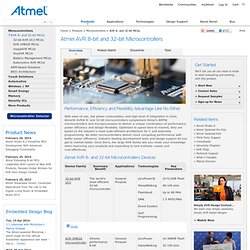
Simply AVR Design Contest… We want your simply awesome, simply AVR-based designs » Watch Now. ECE 353: Introduction to Microprocessor Systems. E C E 353: Introduction to Microprocessor Systems Catalog Description: Introduction to architecture, operation, and application of microprocessors; microprocessor programming; address decoding; system timing; parallel, serial, and analog I/O; interrupts and direct memory access; interfacing to static and dynamic RAM; microcontrollers.
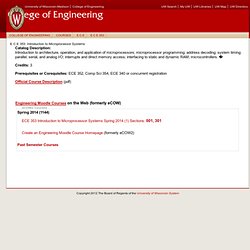
Microprocessor Systems 1. Course Title: Smart Embedded Systems Credit Points: 12 Course Coordinator: Dr P J Radcliffe Course Coordinator Phone: email is preferred Course Coordinator Email:pjr@rmit.edu.au.
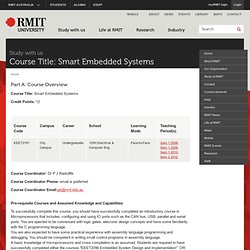
Embedded Systems Course - module 1. MODULE -1 (Introduction) Embedded Systems is simply the brain of the most of the electronics based systems to access, process, store and control the data. Few simple electronics circuits can be intelligently hardware designed without a microprocessor or microcontroller but is not worth the economics except for simple passive operations.
So it's more or less must to put this so called silicon brain, which we engineers call as microcontroller in all electronics systems. Embedded market is experiencing best of it's times and double-digit market growth will continue for some more years. It will continue to grow as long as semiconductor ICs are used for data processing. List of Intel microprocessors. Intel CPU (covered by a heatsink fan) mounted on a motherboard This generational and chronological list of Intel processors attempts to present all of Intel's processors from the pioneering 4-bit 4004 (1971) to the present high-end offerings, which include the 64-bit Itanium 2 (2002), Intel Core 2, and Xeon 5100 and 7100 series processors (2006). Concise technical data are given for each product. The 4-bit processors[edit] Intel 4004[edit] First microprocessor (single-chip IC processor) Clock rate 740 kHz[1]0.07 MIPSBus width 4 bits (multiplexed address/data due to limited pins)PMOSNumber of transistors 2,300 at 10 μmAddressable Memory 640 bytesProgram Memory 4 KBOne of the earliest Commercial Microprocessors (cf.
Microprocessor Simulator for Students. Click the image for a large screen shot view. If you are looking for Neil's simulator for the UK AQA GCE in Electronics, it's here with the documentation here. Download for Win32 - Win95/98/ME/NT/2000/XP/2003/Windows 7 - Not tested with Vista but it probably works. This program does not need to be installed as it makes no regristry changes.
Just extract the files into a folder and make your own shortcut to the EXE file. This also allows it to be run from a network share. 68HC12. Azhar Microprocessor Simulator Tutorial HD. Top 40 Arduino Projects of the Web. Index of /~ymeng/courses/CPE390/notes.
Embedded System Design Course Description. Embedded Systems. EE281: Embedded System Design Laboratory. Embedded Systems 2012. Embedded system. Intelligent Embedded Systems. Spring 2000. EE192C - Embedded Systems Engineering. Embedded System Design Issues (the Rest of the Story) Philip J. Koopman, Jr Preprint of paper published in:Proceedings of the International Conference on Computer Design (ICCD 96) in conjunction with an embedded tutorial session of the same title.